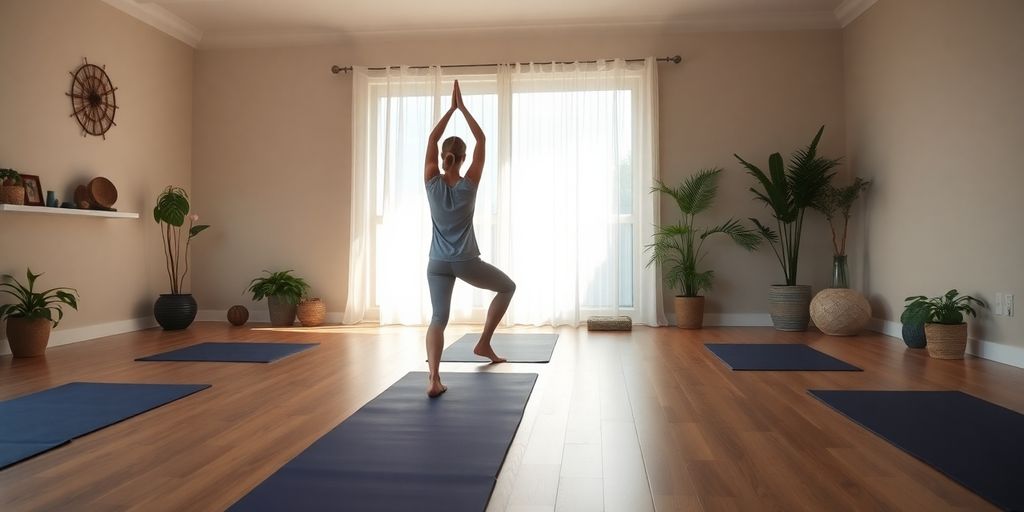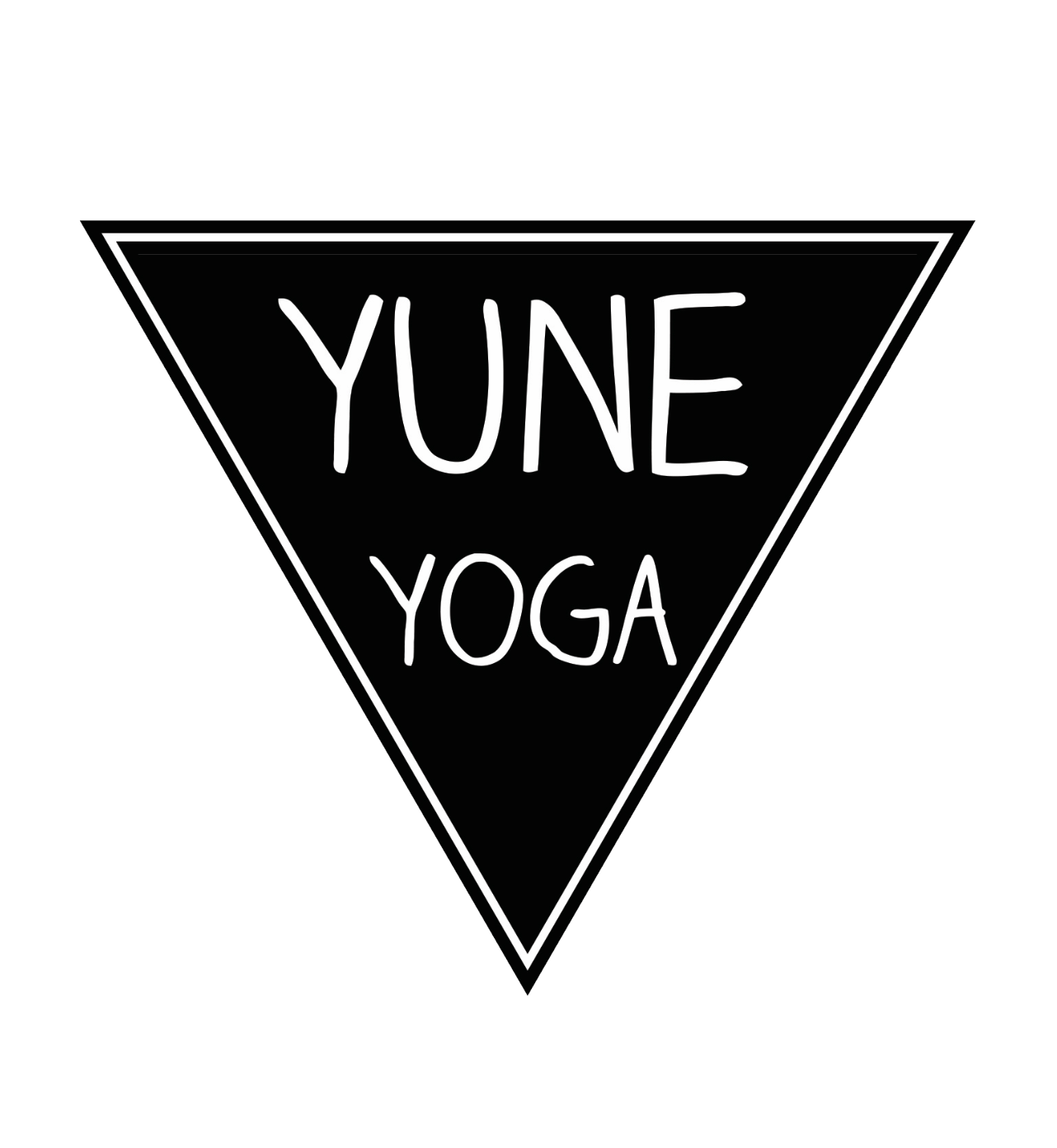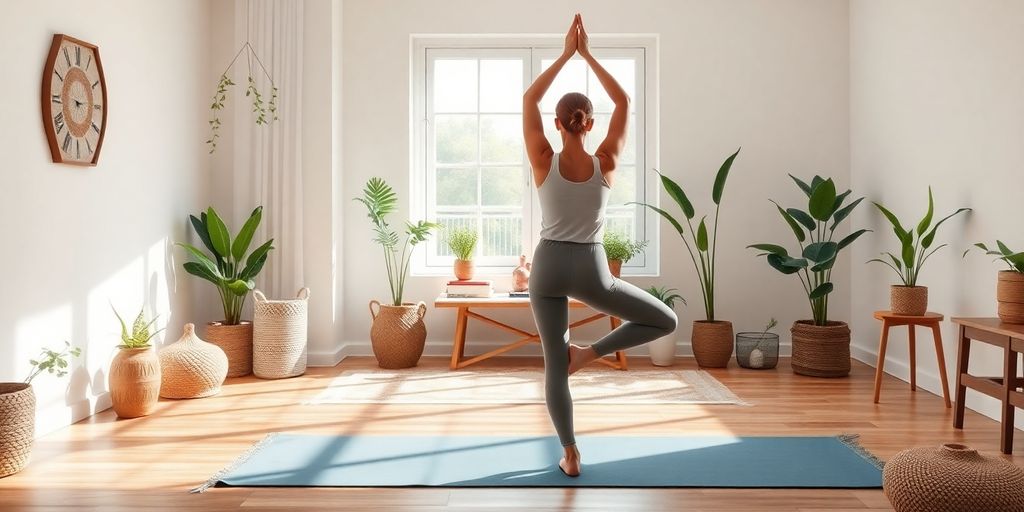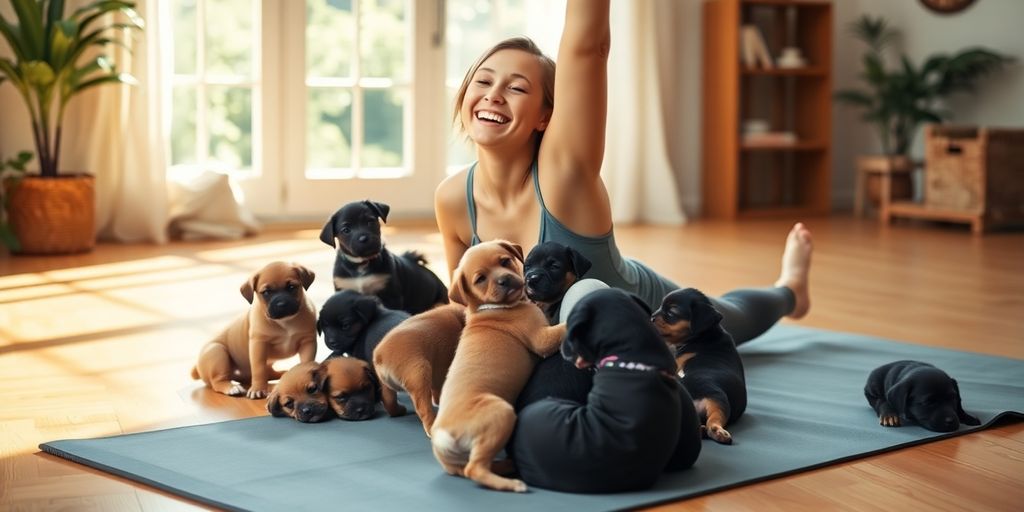
How to Learn Yoga: A Comprehensive Guide for Beginners
Starting yoga can feel a bit overwhelming, especially if you're new to it. With so many styles, classes, and poses, it's easy to get lost. This guide is here to help you understand the basics, find the right equipment, and start your journey in yoga with confidence. Whether you want to improve flexibility, reduce stress, or just try something new, this comprehensive guide will walk you through everything you need to know about how to learn yoga.
Key Takeaways
- Yoga is about uniting the mind, body, and spirit, with many styles to choose from.
- A good mat and comfortable clothing make a big difference in your practice.
- Finding the right class can help you learn faster and feel more comfortable.
- Start with basic poses and gradually build your skills as you go.
- Creating a home practice space can help you maintain consistency.
Understanding The Basics Of Yoga

Yoga can seem like a lot when you're just starting out. All the different poses, the Sanskrit words, and the super-flexible people on Instagram can be intimidating. But don't worry, it's really not as scary as it looks. Let's break down the basics so you can start your yoga journey with confidence.
Definition Of Yoga
So, what is yoga anyway? The word "yoga" comes from Sanskrit and basically means "to unite" or "to join." Think of it as bringing your mind, body, and spirit together. It's not just about stretching; it's about creating harmony within yourself. Many people think of Hatha Yoga when they think of yoga.
History And Philosophy
Yoga has been around for thousands of years, originating in ancient India. It's more than just exercise; it's a whole philosophy of life. The Yoga Sutras of Patanjali, written a long, long time ago, are like the main guidebook for yoga. They talk about how to calm your mind and live a more meaningful life. It's about discipline, self-awareness, and letting go of things that don't serve you. It's a path to clarity, peace, and happiness.
Different Styles Of Yoga
There are tons of different styles of yoga, so you can find one that fits you. Here are a few:
- Hatha: A gentle, slower-paced style that's great for beginners. It focuses on basic poses and breathing.
- Vinyasa: A more dynamic style where you flow from one pose to the next, linking your breath to your movement. It can be a good workout!
- Ashtanga: A set sequence of poses that you do in the same order every time. It's challenging and builds strength and stamina.
- Restorative: A super relaxing style where you hold poses for a long time with the help of props like blankets and pillows. It's great for stress relief.
Yoga isn't about being perfect; it's about showing up for yourself and doing what you can. It's about listening to your body and honoring its limits. It's about finding a little bit of peace and calm in the middle of a busy world.
Finding the right style is important. You can find beginner poses that work for you.
Essential Yoga Equipment For Beginners

Alright, so you're thinking about getting into yoga? Awesome! You don't need a ton of fancy stuff to get started, but having a few key items can really make your practice more enjoyable and effective. Let's break down the basics.
Choosing The Right Mat
Okay, first things first: the yoga mat. This is probably the most important piece of equipment you'll get. Think of it as your personal space, your foundation. You want something that's grippy enough so you don't slip and slide all over the place, but also comfortable enough to support your joints.
There are a ton of options out there, and it can be overwhelming. Here's a quick rundown:
- PVC Mats: These are usually the most affordable, but they can be less eco-friendly and might get slippery when you sweat a lot. If you are looking for yoga mats that are budget friendly, this might be the right choice.
- TPE Mats: A good middle-ground option. They offer good grip and cushion, and are often more eco-friendly than PVC.
- Natural Rubber Mats: These are super grippy and eco-friendly, but they can be a bit pricier and might have a slight rubber smell at first.
- Thickness: Consider how much cushioning you want. A thicker mat (around 5-6mm) is great for protecting your joints, while a thinner mat (around 3-4mm) can give you better stability for balance poses.
Comfortable Clothing
Next up: what to wear. The key here is comfort and freedom of movement. You don't need to go out and buy a whole new yoga wardrobe, just wear something that lets you stretch and bend without feeling restricted.
- Breathable Fabrics: Look for fabrics that wick away sweat, like cotton or synthetic blends.
- Fitted or Close-Fitting: Avoid anything too baggy that could get in the way during poses. Think leggings, yoga pants, or fitted shorts. A sweat-wicking workout top is also a good idea.
- Layers: It's always a good idea to have a light layer, like a sweatshirt or cardigan, that you can put on during warm-up or cool-down.
Additional Props And Accessories
Once you've got your mat and your comfy clothes sorted, you might want to consider a few extra props to help you deepen your practice. These aren't strictly necessary, but they can be really helpful, especially when you're just starting out.
- Yoga Blocks: These are great for bringing the floor closer to you in poses like Triangle or Half Moon. They can also provide support in seated poses. Yoga blocks are a great tool for beginners.
- Yoga Strap: A strap can help you extend your reach in poses like seated forward folds or Cow Face pose. If you have tight hamstrings, a strap can be a lifesaver.
- Blanket: A folded blanket can provide cushioning for your knees or support in restorative poses. It's also nice to have for warmth during savasana (corpse pose).
Don't feel like you need to buy everything all at once. Start with the basics – a good mat and comfortable clothes – and then add props as you feel like you need them. You can even get creative and use household items like books or towels as substitutes for blocks and blankets.
Finding The Right Yoga Class
Choosing the right yoga class can feel overwhelming, especially with so many options available. Don't worry, it doesn't have to be! It's all about finding a class that fits your current fitness level, your goals, and your personal preferences. Let's break down how to find the perfect fit for you.
Types Of Classes Available
Yoga isn't just one thing; there are many different styles, each with its own focus and intensity. Some popular types include:
- Hatha: A good starting point, hatha yoga is generally slower-paced and focuses on basic poses.
- Vinyasa: This style links movement with breath in a flowing sequence. It can be more physically demanding.
- Ashtanga: A set sequence of poses, Ashtanga is a rigorous and athletic style.
- Yin: This involves holding poses for longer periods, targeting deep connective tissues. It's great for flexibility and relaxation.
- Restorative: A very gentle style using props to support the body in relaxing poses.
- Bikram: Done in a heated room, this style follows a specific sequence of poses.
How To Choose A Class
Consider these factors when selecting a class:
- Your experience level: Look for classes specifically labeled "beginner" or "level 1." These will introduce you to the basics without pushing you too hard.
- Your fitness goals: Are you looking to build strength, increase flexibility, reduce stress, or something else? Different styles cater to different goals.
- The class description: Read the description carefully to understand the focus and intensity of the class. Don't be afraid to contact the studio or instructor if you have questions.
- The instructor's qualifications: Check the instructor's experience and certifications. A good instructor will be able to modify poses for different levels and address any concerns you may have.
- Class schedule and location: Choose a class that fits your schedule and is conveniently located. Consistency is key to building a yoga practice.
What To Expect In Your First Class
Your first yoga class can be a little nerve-wracking, but knowing what to expect can help ease your anxiety. Here's a general idea:
- Arrive early: Give yourself time to check in, set up your mat, and get comfortable.
- Introduce yourself to the instructor: Let them know you're new to yoga and if you have any injuries or concerns.
- Listen to your body: Don't push yourself too hard, especially in the beginning. Modify poses as needed and take breaks when you need them.
- Focus on your breath: Breath is an important part of yoga. Pay attention to your breath and try to coordinate it with your movements.
- Don't compare yourself to others: Everyone is at a different stage in their yoga journey. Focus on your own practice and progress.
Remember, finding the right yoga class is a personal journey. Don't be afraid to try different styles and instructors until you find what works best for you. The most important thing is to have fun and enjoy the process!
Fundamental Yoga Poses For Beginners
Basic Standing Poses
Okay, so you're ready to actually do some yoga? Awesome! Let's start with standing poses. These are great because they help build strength, improve your balance, and get you more aware of your body in space. Don't worry if you wobble a bit – everyone does when they're starting out. The key is to focus on your alignment and breath.
- Mountain Pose (Tadasana): This might seem like just standing, but it's the foundation for all other standing poses. Engage your leg muscles, lengthen your spine, and feel your feet grounding into the earth. It's all about body awareness and alignment.
- Warrior I (Virabhadrasana I): A powerful pose that strengthens your legs, opens your chest, and builds stamina. Make sure your front knee is directly over your ankle and your back foot is firmly planted.
- Warrior II (Virabhadrasana II): Another great pose for building leg strength and opening your hips. Focus on keeping your shoulders relaxed and your gaze soft over your front hand.
Seated Poses
Seated poses are fantastic for improving flexibility, calming the mind, and connecting with your breath. They can be a little challenging at first if you're not used to sitting on the floor, so don't be afraid to use a cushion or folded blanket to support your hips.
- Easy Pose (Sukhasana): Despite its name, it might not feel so easy at first! Focus on sitting tall, lengthening your spine, and relaxing your shoulders. This is a great pose for chanting of mantras or meditation.
- Staff Pose (Dandasana): This pose helps you to improve your posture. Sit with your legs extended in front of you, feet flexed, and spine straight. Press your hands into the floor beside your hips to help you sit taller.
- Seated Forward Fold (Paschimottanasana): This pose stretches the entire back of your body, from your head to your heels. If you can't reach your toes, that's okay! Just focus on lengthening your spine and folding forward as far as is comfortable.
Restorative Poses
Restorative poses are all about relaxation and rejuvenation. They're designed to help you release tension, calm your nervous system, and promote a sense of well-being. These poses are often held for longer periods of time, allowing you to fully relax and surrender into the support of the props.
- Child's Pose (Balasana): A classic restorative pose that gently stretches your hips, thighs, and ankles while calming your mind. Rest your forehead on the floor and let your body sink into the pose.
- Corpse Pose (Savasana): The final resting pose in most yoga classes. Lie on your back with your arms at your sides, palms facing up, and let your entire body relax. This is a time for complete surrender and integration of your practice.
- Supported Reclining Bound Angle Pose (Supta Baddha Konasana): This pose gently opens your hips and groin while supporting your back and knees. Use pillows or blankets under your knees for added comfort.
Remember, yoga is not about achieving perfect poses. It's about connecting with your body, breath, and mind. Be patient with yourself, listen to your body, and enjoy the journey.
Incorporating Breathwork Into Your Practice
Understanding Pranayama
Pranayama, often translated as "breath control," is a core element of yoga that goes way beyond just breathing. It's about manipulating your breath to influence your energy levels and mental state. Think of it as a bridge connecting your body and mind. It's not just about taking deep breaths; it's about understanding how different breathing techniques can affect you.
Breathing Techniques For Beginners
Okay, so where do you start? Here are a few simple techniques to get you going:
- Diaphragmatic Breathing (Belly Breathing): Lie down, place one hand on your chest and the other on your belly. Inhale deeply, feeling your belly rise while your chest remains relatively still. Exhale slowly, letting your belly fall. This helps activate your parasympathetic nervous system, promoting relaxation. It's a great way to start and promote mindfulness.
- Ujjayi Breath (Ocean Breath): This involves a slight constriction in the back of your throat, creating a soft, ocean-like sound with each inhale and exhale. It helps focus your mind and generate internal heat. It's a bit tricky at first, but keep at it!
- Alternate Nostril Breathing (Nadi Shodhana): Use your fingers to close one nostril while inhaling through the other. Then, switch nostrils and exhale. This is said to balance the energy channels in your body. It can be very calming.
Benefits Of Breath Control
Breath control, or pranayama, offers a bunch of benefits. It's not just some woo-woo thing; there's real science behind it. Here's a quick rundown:
- Reduced stress and anxiety
- Improved focus and concentration
- Lower blood pressure
- Better sleep
- Increased energy levels
Taking control of your breath is like having a remote control for your nervous system. It's a powerful tool that you can use anytime, anywhere, to manage stress, improve focus, and enhance your overall well-being. It's worth the effort to learn and practice these techniques regularly. You can also explore different yoga styles to find what works best for you.
Practicing Yoga At Home
So, you're thinking about doing yoga at home? Awesome! It's a great way to fit yoga into your life, especially when you can't make it to a class. It's more convenient, often cheaper, and you can totally customize it to fit your needs. But where do you even start?
Creating A Home Practice Space
First things first: you need a space. It doesn't have to be huge or fancy. Just a quiet corner where you can unroll your mat and move without bumping into things. Clear out any clutter, maybe light a candle or diffuse some essential oils if that's your thing. The goal is to create a calming environment where you can focus on your practice. I personally love practicing near a window for some natural light, but whatever works for you!
Online Resources And Apps
Okay, now for the tech. There are tons of online resources and apps that can guide you through yoga sessions. YouTube is a goldmine for free classes, but if you're willing to spend a little, apps like Down Dog or Glo YogaGlo offer personalized routines and a wider variety of styles. It's really about finding what resonates with you. I've tried a bunch, and some instructors just click better than others. Don't be afraid to experiment!
Here's a quick comparison of some popular options:
| Resource | Cost | Pros | Cons |
|---|---|---|---|
| YouTube | Free | Huge variety, free | Quality varies, can be distracting |
| Down Dog | Subscription | Highly customizable, good for all levels | Can feel repetitive after a while |
| Glo | Subscription | Wide range of classes and instructors, high-quality production | More expensive than other options |
| Local Studio | Varies | In-person guidance, community aspect | Less flexible schedule, can be more expensive per class |
Establishing A Routine
This is where things can get tricky. It's easy to start strong and then let your home practice fizzle out. The key is consistency. Start small – even 15-20 minutes a few times a week is better than nothing. Schedule it into your calendar like any other appointment, and try to stick to it. Maybe do it first thing in the morning to set the tone for the day, or in the evening to wind down. Find a time that works with your life, not against it. Also, don't beat yourself up if you miss a day. Just get back on the mat the next day. Remember to check out some bedtime yoga for relaxation.
Setting up a home yoga practice is a journey, not a destination. Be patient with yourself, listen to your body, and don't be afraid to modify poses as needed. The most important thing is to enjoy the process and make it a sustainable part of your life. Over time, you'll find what works best for you, and your home practice will become a source of strength, flexibility, and peace.
Yoga Etiquette And Community
Classroom Etiquette
So, you're ready to hit the yoga studio? Awesome! But before you roll out your mat, let's talk about some unwritten rules. Think of it as being a good neighbor in the yoga world. First off, try to arrive a few minutes early. Rushing in late disrupts the calm vibe everyone's trying to achieve. Find a spot, unroll your mat quietly, and settle in. Phones should be silenced – seriously, nobody wants to hear your ringtone during Savasana. And while we're at it, keep conversations to a minimum before class starts. It's cool to say hi, but save the long chats for after. Also, removing your shoes before entering the practice space is generally expected. It's a sign of respect, kind of like entering someone's home. If the teacher offers adjustments, know that you can always decline. It's your body, your practice. Just a simple "no, thank you" is perfectly fine. And lastly, try to stay for the entire class, including Savasana. That final resting pose is super important for integrating the practice. If you absolutely have to leave early, let the instructor know beforehand and slip out quietly before Savasana begins. Following these simple guidelines helps create a positive experience for everyone.
Respecting Others In Class
Yoga is a personal journey, but it's also a shared experience. Being mindful of others in the class is key. Personal hygiene is important. Make sure you're clean and fresh – nobody wants to be downwind of strong body odor during a close-quarters pose. Be aware of your space. Try not to encroach on your neighbor's mat, and be mindful of flailing limbs during poses like Warrior Two. If you need to move or adjust your position, do so slowly and deliberately, avoiding sudden movements that could startle others. Avoid talking during class unless the instructor specifically asks for feedback or questions. It's distracting and disrespectful to those trying to focus. And finally, be accepting of all levels and abilities. Yoga is for everyone, regardless of experience or flexibility. Offer encouragement and support to your fellow yogis, and remember that we're all on our own unique path. If you are looking for yoga journal, there are many resources online.
Building A Supportive Community
Yoga can be so much more than just a workout; it can be a source of connection and support. One of the best ways to build community is to simply be open and friendly. Introduce yourself to your classmates, strike up conversations before or after class, and share your experiences. Consider attending studio events or workshops. These are great opportunities to connect with like-minded people and deepen your practice. You can also join online yoga communities. There are tons of forums and social media groups where you can share tips, ask questions, and connect with yogis from all over the world.
Remember, a supportive yoga community can be a powerful source of encouragement and motivation. It's a place where you can feel safe, accepted, and inspired to grow, both on and off the mat. Don't be afraid to reach out, connect with others, and build meaningful relationships within your yoga community. You might be surprised at the friendships you form and the support you receive.
And don't forget to support your teachers! A simple thank you after class goes a long way. If you appreciate their guidance, consider writing a review or recommending them to friends. Showing your appreciation helps create a positive and supportive environment for everyone. If you are looking for yoga poses, there are many resources online.
Wrapping It Up
So, there you have it! Starting yoga doesn’t have to be scary. Just remember, everyone was a beginner at some point. Take your time, listen to your body, and don’t stress about getting every pose perfect. It’s all about finding what feels good for you. Whether you join a class or practice at home, keep it simple and enjoy the journey. With patience and practice, you’ll see the benefits unfold. Happy stretching!
Frequently Asked Questions
What is yoga?
Yoga is a practice that helps connect the mind, body, and spirit. It includes physical postures, breathing exercises, and meditation.
Do I need to be flexible to start yoga?
No, you don’t need to be flexible to start yoga. Yoga is about improving your flexibility over time.
How often should I practice yoga as a beginner?
As a beginner, try to practice yoga 2 to 3 times a week to build a routine and improve your skills.
What equipment do I need for yoga?
All you really need is a yoga mat. Comfortable clothes are also important, and you can use props like blocks or straps as you progress.
Can I do yoga at home?
Yes! You can practice yoga at home by following online videos or using yoga apps to guide you.
What should I expect in my first yoga class?
In your first class, you’ll learn basic poses and breathing techniques. The instructor will guide you through the class and help you feel comfortable.


